University of North Alabama
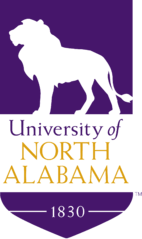 | |
| Motto | "Veritas Lux. Orbis Terrarum" (Latin: "Truth and Light of the World") |
|---|---|
| Type | Public |
| Established | 1830 |
| Endowment | $30,000,000 |
| President | Kenneth D. Kitts |
Academic staff | 365 |
| Students | 7,497 |
| Location |
Florence, Alabama, U.S. 34°49′N 87°41′W / 34.81°N 87.68°WCoordinates: 34°49′N 87°41′W / 34.81°N 87.68°W |
| Campus | Urban, 130 acres (0.526 km²) |
| Colors |
Purple and Gold[1] |
| Athletics | NCAA Division II – Gulf South |
| Nickname | Lions |
| Mascot | Leo III & Una |
| Website |
www |
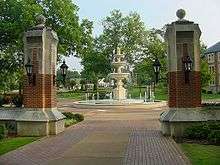
The University of North Alabama (UNA) is a coeducational university located in Florence, Alabama. It is the state's oldest four-year public university. Occupying a 130-acre (0.5 km2) campus in a residential section of Florence, UNA is located within a four-city area that also includes Tuscumbia, Sheffield and Muscle Shoals. The four cities comprise a metropolitan area with a combined population of 140,000 people.[2]
The University of North Alabama was founded as LaGrange College in 1830. It was reestablished in 1872 as the first state-supported teachers college south of the Ohio River. A year later, it became one of the nation's first coeducational colleges.[3][4]
The University of North Alabama has developed into a comprehensive regional university exerting a major influence over the cultural, social and economic life of Northwest Alabama and providing educational opportunities for students pursuing undergraduate and graduate majors offered through the colleges of Arts and Sciences, Business, Education and Nursing and Health.[2]
The 2008 edition of U.S. News and World Report's America's Best Colleges ranked the university as a top-tier public university.[5]
History
| “ | They called it 'LaGrange' meaning 'the place,' for the view from the area was breathtaking. | ” | |
| — A History of LaGrange College | |||
The University of North Alabama opened its doors as LaGrange College on January 11, 1830, in a mountain hamlet a few miles south of Leighton in northeast Colbert County, Alabama. LaGrange means "The Barn" in French. Twenty-one local college trustees were listed in Acts of Alabama, Eleventh Annual Session.

The town of LaGrange and its college were sacked and burned by Union troops in 1863. But by then, however, the college had moved north across the Tennessee River to Florence. The section of Franklin County containing LaGrange Mountain is now Colbert County. LaGrange College, which became Florence Wesleyan University in 1855, is now the University of North Alabama.
LaGrange College arose from the idea offered at a November 28, 1826 meeting of the Tennessee Conference of the Methodist Episcopal Church to establish a college which would not be "religious or theological". By January 1829, the selection of Lawrence Hill on LaGrange Mountain was made for the site of the school.
A year later, LaGrange College opened to students of all denominations in two three-story brick buildings.
The Rev. Robert Paine was the first president. The North Carolina native was also the professor of moral science and belles lettres and taught geography and mineralogy. He was assisted by two other professors. The first board of trustees had a total of 50 members, including two Native Americans, a Choctaw politician and a Cherokee leader. In 1830, Turner Saunders, a native of Virginia, was the first President of the Board of Trustees. Saunders' mansion, built aground 1826, still stands in Lawrence County. Among the many distant trustees was John Coffee of Florence, friend of Andrew Jackson. Among the local trustees was Henry Stuart Foote of Tuscumbia, who would move to Mississippi and defeat Jefferson Davis in the 1850 Governor's election. J.D. Malone, of Limestone County, was the first graduate in 1833.
In 1850, a grammar school was added to LaGrange College. (Today, UNA has the only university-owned and operated elementary laboratory school - Kilby Professional Laboratory School - in Alabama.) In 1858 the death of the school's president and the loss of most of its students to nearby Florence, the college was suspended and re-established as the LaGrange College and Military Academy, with James W. Robertson as superintendent. Under its new name, additional buildings were constructed and the school reached its highest prosperity. the state of Alabama made provision for two cadets from each county to be enrolled, and by 1861 47 of its 171 students were state cadets. The school suffered a loss of enrollment again when Alabama seceded, and in March 1862 Robertson received approval from the Alabama governor to enroll the 35th Alabama Infantry from faculty, cadets, and enlistees from surrounding counties.
On April 28, 1863, the buildings were destroyed by Union soldiers of the 10th Missouri Cavalry, including a library of 4,000 volumes.
Among LaGrange's alumni were several generals, Alabama governors Edward A. O'Neal and David P. Lewis, Alabama Supreme Court justice William M. Byrd and U.S. Senator Jeremiah Clemens, who wrote the first American Civil War novel and the first western novel.[3]
Florence Wesleyan University

LaGrange graduate Dr. Richard H. Rivers, after becoming president of the college, led most of the students and all but one faculty member from the mountain in late 1854 to relocate to Florence. The school was re-incorporated as Florence Wesleyan University.
Admission to Florence Wesleyan required an acquaintance with English grammar, arithmetic, geography and the Latin and Greek Grammar. Prospective students also were required to demonstrate an ability to translate four books of Caesar's Gallic Wars, six books of Virgil's Aeneid, Jacob's or Felton's Greek Reader, and at least one of Xenophon's Anabasis.[6]
One hundred and 60 students enrolled in the first year of operation (1855) of Florence Wesleyan University. The school quickly attracted students from five states and two foreign countries. Among Florence Wesleyan's graduates were Alabama governor Emmet O'Neal and Texas governor Lawrence Sullivan "Sul" Ross (the latter of whose tenure as president of Texas A&M University was known as the 'golden age' of that institution).[3] Ross also is the namesake of Sul Ross State University in Alpine, Texas.[6]
The Civil War
The American Civil War bestowed much hardship on the institution.[3] Robert A. Young, president of Florence Wesleyan at the time, is credited with saving the institution from destruction.[6]
Florence Wesleyan alumnus Lawrence "Sul" Ross, the future Texas governor and university educator, served as a general in the Confederate States Army. LaGrange College and Florence Wesleyan University also produced three other Civil War generals: Confederate Generals Edward A. O'Neal (later an Alabama governor) and John Gregg and Union General Daniel McCook, Jr.[6]
State Normal School at Florence

When the Methodist Church deeded Florence Wesleyan to the State of Alabama in 1872, the institution became the State Normal School at Florence, the first state-supported teachers college south of the Ohio River. Shortly thereafter, it became one of the first co-educational institutions in the nation. A year after its becoming a state school, the institution opened its doors to women; however, none attended until 1874, when 31 young women enrolled. The first woman joined the faculty in 1879.[3]
Florence Normal School's Newton W. Bates, professor of language and literature, published his History of Civil Government of Alabama in 1892, the first textbook on the history of Alabama.[6]
T.S. Stribling, one of the university's most noteworthy alumni, graduated from Florence State Normal School in 1903. He is recognized as one of the leaders of the Southern Renaissance for his novels Birthright, The Forge, The Store and the Unfinished Cathedral. The Pulitzer prize-winning novelist and author also outsold contemporaries William Faulkner and Ernest Hemingway during the interwar period of the 1920s and 1930s.[6]
Florence State Teachers College
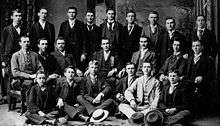
The institution functioned as a normal school for more than 50 years until 1929, when it became a state teachers college offering a four-year curriculum in elementary education.
The first bachelor's degrees were awarded in 1931. Less than a decade later, the curriculum was expanded to include a four-year course of study in secondary education. In 1947, the curriculum was expanded again to include A.B. and B.S. degree programs in fields other than teacher training.[7]
Florence State College
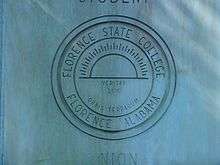
Progress continued apace toward the comprehensive university the institution ultimately would become. In 1956, the institution crossed another academic milestone with the formation of a graduate course of study in education leading to the Master of Arts degree. With the establishment of a new Graduate Division, the graduate program was launched in the summer of 1957. The same year, the Alabama Legislature voted to change the institution's name to Florence State College to reflect its expanding academic mission.[7]
Integration at Florence State College
Compared with other southern institutions of higher learning, particularly the universities of Alabama and Mississippi, integration occurred almost painlessly at Florence State College.
In 1963, Wendell Wilkie Gunn became the first African-American student to enroll at the college. Gunn had been denied admission, even though he had the support of the college's president and administration. Then-President E.B. Norton reluctantly sent Gunn a letter informing him that the Alabama Legislature and Board of Education would not allow the college to accept his application. Speaking at UNA in 2005, famed civil rights attorney Fred Gray, who defended Gunn, recalled that the hearing that integrated UNA lasted only ten minutes, after which Gunn returned to campus and enrolled. Gray describes the episode as "the easiest case of my civil rights career."[8]
Gunn, who subsequently earned degrees from Florence State College and the University of Chicago, went on to a distinguished career and was appointed a special assistant to President Ronald Reagan in 1982.[9]
Florence State University
In 1967 when the Alabama Legislature removed jurisdiction for the college from the State Board of Education and vested it in a Board of Trustees. A year later, the new board voted for another name change to Florence State University, once again symbolizing the steady expansion of the institution's academic offerings and mission.[7]
Ethelbert Brinkley "E.B." Norton, who was serving as president at the time this name was adopted, is distinguished as the only president in the university's history to preside over three institutional name changes: Florence State Teachers College, followed by Florence State College in 1957, and, roughly a decade later, by Florence State University.[6]
[Research and verification needed here. Dr. Keller was the college president when he killed in an auto accident in the late 1940s/early 1950s. He was succeeded by Dr. Norton. Dr. Keller may have been president at the time of the name change in 1929.]
The change of name also was accompanied by an extensive reorganization of the university's academic and administrative structure, including the establishment of separate schools within the university.[7]
The University of North Alabama
Less than a decade later, on August 15, 1974, the university underwent another change of name to the University of North Alabama, symbolizing its coming of age as a comprehensive, regional university. The following year, the graduate curriculum again was expanded with the introduction of the master's degree program in business administration.
Following a reorganization in 1991, the university's administrative structure consists of four divisions: Academic Affairs, Business Affairs, Student Affairs and Advancement, each headed by a vice president. In 1993, the Board of Trustees, anticipating continued and steady enrollment growth, adopted a new master facilities plan to ensure that UNA will be equipped to accommodate 10,000 students.[7]

Dr. William G. Cale Jr., became president of the University of North Alabama on January 15, 2005, four days after the university marked the 175th anniversary of its founding as LaGrange College. A Philadelphia native, Cale came to UNA from Pennsylvania State University-Altoona, where he served as chief executive officer and dean. He had been the executive vice president for Academic Affairs at Lamar University in Beaumont, Texas.[10]
Cale was succeeded in 2015 by Dr. Kenneth D. Kitts, formerly provost at the University of North Carolina at Pembroke. Kitts also taught at Francis Marion University in South Carolina, the University of South Carolina, and Appalachian State University in North Carolina.[11]
Campus
| “ | …to provide aesthetic and cultural enrichment and activities for the surrounding community. | ” | |
| — UNA Statement of Purpose, Role and Goals | |||

The University of North Alabama and the surrounding residential area share a rich history. The UNA campus is adjacent to the Seminary-O'Neal Historic District, named for the street on which the Synodical Female College was located and for two Alabama governors. The district, which is listed in the National Register of Historic Places, also is noted for its residential structures, built between 1908 and 1943 and representing a wide array of architectural styles.[12]
UNA's campus facilities master plan was developed by the Olmsted Brothers, the sons of the architect who designed New York City's Central Park. A copy of the original Olmsted plan is permanently displayed in the President's Office in Bibb Graves Hall.[13]
The modern campus is distinguished by its shaded walkways, spacious green lawns, fountains, sculptures and historic buildings. UNA also is noted for its three antebellum structures: Wesleyan Hall; Rogers Hall; and Coby Hall.[3] All three buildings are listed in the National Historic Register.[6]
Gifts from friends and alumni and federal grants made possible a massive renovation of the UNA campus to conform with the landscape design formulated by Olmstead brothers. The university was transformed into an almost entirely pedestrian campus, with a brick walkway added to simulate the nearby Tennessee River and accented with fountains designed by Hugo Dante, of the Hill and Jangaard architectural firm, of Florence.[14]
Science and Engineering Technology Building
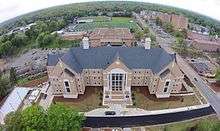
The UNA Science and Engineering Technology Building was completed in 2015. The five-story, 160,000-square-foot facility was designed by Lambert Ezell Durham Architects and constructed by BL Harbert, The state-of-the-art building houses engineering technology, biology, chemistry, industrial hygiene, physics and earth science It also includes conference areas, faculty offices, research facilities, specialized classrooms, a dining area, computer laboratories, super laboratories and lecture halls. The UNA Science and Engineering Technology Building is a FEMA rated storm shelter capable of withstanding an F5 tornado.[15]
The Commons Building
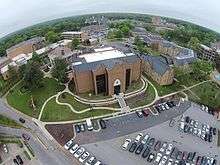
The Commons Building was completed in 2014 and is located between Rogers Hall and Keller Hall at the north end of Court Street. The $8 million complex houses the University Success Center, Student Financial Services, the UNA branch of Listerhill Credit Union, a campus bookstore, Starbucks and Chik-fil-A. The Commons Building was designed by Hugo Dante and Create Architects, and was built by Consolidated Construction.[16]
Mattielou and Olive Residence Halls
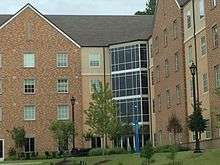
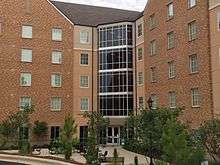
Mattielou and Olive residence halls were completed in fall 2015 and spring 2016, respectively. The new residence halls are located on the extreme north end of campus, behind Covington and Hawthorne halls. Mattielou has 335 spaces and Olive has 429 spaces. These buildings were built primarily for incoming freshmen students. There are double and limited single rooms and each unit has its own bathroom.[17]
Laura Harrison Plaza
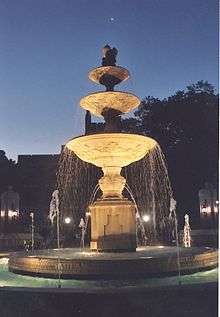
The undertaking culminated in October, 2002, with the dedication of the Harrison Plaza, made possible by Laura McAnally Harrison, a 1955 graduate of Florence State Teachers College (now the University of North Alabama) and her husband, Dr. Donald C. Harrison, of Cincinnati. The plaza, constructed around a large Italian limestone fountain, occupies the former intersections of Morrison and Wesleyan Avenues and Seminary Street between Bibb Graves Hall, Keller Hall and the George H. Carroll Lion Habitat, which houses UNA's live mascots. Harrison Plaza now constitutes the hub of UNA's three pedestrian walkways and serves as the principal entrance to campus.[14]
Wesleyan Hall and Bell
With its distinctive towers, Wesleyan Hall, one of UNA's most familiar structures, also is considered one of the most eminent landmarks in North Alabama. The Gothic Revival structure was designed to serve LaGrange College when this Methodist institution relocated from Franklin to Lauderdale county and was renamed Florence Wesleyan University. During the Civil War, Wesleyan Hall was occupied by both Union and Confederate armies.[13] General William Tecumseh Sherman is considered the most famous Civil War-era occupant of Wesleyan Hall.[6]
After the war, the building was deeded to the state of Alabama and thereafter served as a state normal school.[13] Now it is the center for Foreign Languages (French, German, and Spanish), Psychology, and Geography.
Wesleyan Hall houses personal effects and mementoes of former Alabama Supreme Court Chief Justice and U.S. Senator Howell Heflin, a native of nearby Tuscumbia. The building is listed in the National Register of Historic Places.
Adjacent to Wesleyan Hall in a specially constructed tower is the Wesleyan Bell, which tolled regularly throughout the last quarter of the 19th century to summon Florence Normal School students to class. Sometime around 1910, the bell was removed from Wesleyan Hall and stored. Rediscovered in 2002, the 130-year-old Wesleyan Bell was restored to a prominent place on campus following construction of the Smith Bell Tower in 2004.[13]
Rogers Hall (Courtview)
Rogers Hall, another one of UNA's most distinctive structures, was constructed by planter George Washington Foster in 1855 at the summit of Court Street (hence its original name, Courtview). Because construction would result in the permanent obstruction of a major thoroughfare, the city had to secure the approval of the Alabama Legislature before work could begin. In the fall of 1864, the residence served as the headquarters of Confederate Gen. Nathan Bedford Forrest. Courtview was occupied by members of the Foster family until 1900, when it became the home of Alabama Gov. Emmet O'Neal. In the 1920s, the residence was acquired by Thomas M. Rogers, Sr., and in 1948 by the university.[13]
Bibb Graves Hall
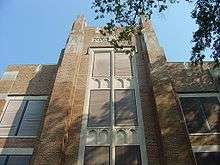
UNA's "main" is Bibb Graves Hall, named after Alabama's "Education Governor," David Bibb Graves, a popular political figure of the state's New Deal era. Constructed during the administration of Dr. Henry Willingham in 1930 and renovated in 1980 and 1989, Bibb Graves Hall functions as the administrative headquarters of the university and houses the university president, vice president of Academic Affairs and the offices of Admissions, Financial Aid and others. Most history and English lectures are held in Bibb Graves Hall.[18]
Coby Hall
Coby Hall, one of the most recent additions to UNA's campus, was donated to the university in 1990 by David Brubaker in memory of his wife, Coby Stockard Brubaker. Built by John Simpson on the site of his earlier home in 1843, the Simpson House/Irvine Place, as it had been known, later was purchased by George W. Foster, builder of Courtview, for his daughter, Virginia, and her husband, James B. Irvine.
Coby Hall also is listed in the National Register of Historic Places.[13]
The Institute for Learning in Retirement and facilities for Continuing Education and Outreach are located in the building.[19]
The Guillot University Center
The Robert M. Guillot University Center, the hub of student life, is named after one of UNA's former presidents, who served from 1972 to 1989.
Popularly known as the "GUC," it houses the On-Campus Bookstore, the Post Office, Einstein Bros Coffee and Bagels, and the Lion's Den, a place where students can play video games, table tennis, or pool. The GUC also houses Student Activities, Intramural and Recreational Sports, Student Development, and the Student Government Association. The Performance Center, located on the second floor, hosts a variety of events including concerts and comedy acts.[18]
Collier Library
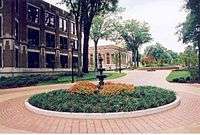
The 330,000-volume Collier Library houses the collections of several musicians, actors, and writers, including W.C. Handy, acclaimed the world over as "father of the blues." The Pulitzer Prize Certificate and Collection of T.S. Stribling, one of the South's premiere novelists and an alumnus of Florence Normal School, also is displayed in the library.
Script collections include those of actors Lucas Black, Ernest Borgnine, Tom Cherones, Elinor Donahue and Noble Willingham. Also included are the scripts of science fiction legend Ray Bradbury and the memorabilia of fellow science fiction great, Forrest Ackerman. The Correspondence Collection of UNA alumnus and trustee Ronnie Flippo, a former U.S. congressman, also is stored in Collier Library.
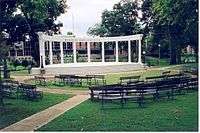
The library also is the location of the George Lindsey Television and Film Collection, part of which is displayed in Norton Auditorium.[13]
The Memorial Amphitheater
The Memorial Amphitheater, located on the grassy commons between Guillot University Center and Collier Library, is another one of the most familiar sites on the University of North Alabama campus. Erected in 1934 as a memorial to World War I veterans, the amphitheater is used for outdoor plays, concerts and speeches. Much like the nearby Guillot Center, it is a popular site for socializing, lounging and studying between classes.[18]
Opler Clock
The Opler Clock is located on Waterloo Road between Floyd Science Building and LaGrange Hall.[13]
Keller Hall
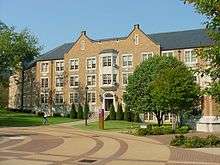
Originally a men's dormitory, Keller Hall, constructed in 1947, is named after Dr. James Albert Keller, who served as president of Florence State Teachers College from 1938 to 1948.
Keller Hall serves as the headquarters of UNA's College of Business, housing the dean, faculty offices, computer labs and classrooms, as well as the Small Business Development Center.[18]
Keller Hall underwent a significant expansion following dedication of the Raburn Wing in 2002. This new addition provides state-of-the-art classrooms and related space for the College of Business.[20]
Willingham Hall
Originally a women's dormitory, Willingham Hall, named after long-serving President Henry J. Willingham, was constructed by the Works Projects Administration in 1939. Willingham Hall houses the Department of English and the Department of History and Political Science. It stands on the site of the old Locust Dell Academy, founded by Nicholas Marcellus Hentz and commemorated by a historical marker.[13]
The President's Home
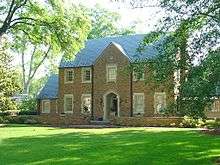
The President's Home, completed in 1941, was constructed by the Works Projects Administration. Occupied by President and Mrs. Kenneth Kitts., the residence is located next to the George H. Carroll Lion Habitat, home of Leo III and Una, the university's live lion mascots. Overnight guests often are awakened by the lions' roaring.[21]
East Campus
The University of North Alabama encompasses two campuses, following a decision in June, 2006, by the university's Board of Trustees to purchase J.W. Powell School from the Florence City Schools. The East Campus houses several academic units, including the Office of Continuing Studies and Outreach and the Human Environmental Sciences' state-of-the-art Culinary Facility. The Culinary Arts program is the only four-year Culinary Program in a public institution of higher learning in Alabama.[22]
Academic programs
| “ | ...for the discovery, preservation, and transmission of knowledge through teaching, research, and public service. | ” | |
| — UNA Statement of Purpose, Role and Goals | |||
Undergraduate programs
The University of North Alabama prides itself on strong academics supported by a dedicated faculty and staff. Toward that end we offer a diverse range of undergraduate and graduate programs coupled with excellent academic support services that meets the educational and career goals for all students.[23][24]
Graduate programs
The University of North Alabama offers graduate programs in business administration; criminal justice; English; community counseling; health promotion and human performance, special education; elementary education; secondary education; and educational administration.[25]
The Alabama Commission on Higher Education had approved UNA's proposal for a master of arts in history.[26]
The advanced degree program, which began accepting students in spring 2007, offered a full course load this fall. The university anticipates that the program, which partly was established to meet local demand for such a degree, will attract between 15 and 20 new students each year. Dr. Evan Ward, director of the program, says that all of the instructors are involved in historical research and that the quality of instruction will rival those of institutions offering similar courses of study.[27]
Distinctive academic programs
Entertainment Industry
The University of North Alabama was the first major university to offer a four-year degree in commercial music, which has become one of the university's most successful programs - one that has been enhanced by the development of the UNA Entertainment Industry Center and the addition of an entertainment industry major. In later years, UNA transitioned the Entertainment Industry Center into a fully functioning academic department. The Department of Entertainment Industry offers degrees in Entertainment Business and Entertainment Technology. The department has moved off campus into downtown Florence next door to Noiseblock Music Group. UNA commercial music majors have interned in record industry offices in Nashville, New York, Los Angeles, London, Stockholm, and nearby Muscle Shoals, world-renowned for its recording industry.
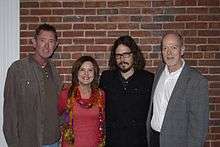
One of the most recognizable graduates of the Entertainment Industry program is John Paul White (’99). White is an American singer-songwriter, and was a member of the Grammy Award-winning duo The Civil Wars. White is a co-owner of Single Lock Records. His new album, "Beulah", was released on August 19, 2016.
Engineering Technology
UNA recently launched the first engineering curriculum in the school’s history, a four-year degree in Engineering Technology. The curriculum focuses on Electro-Mechanical Engineering and prepares our students for a multitude of career choices such as design engineering, robotics, engineering management, automated manufacturing, entrepreneurship and further advanced education.
Human Computer Interaction/User Experience
Human Computer Interaction/User Experience (HCI/UX) explores applied design, diverse forms of communication, cognitive processes and software development, in the context of how people interact with computing systems for real-world application. Experts from relevant academic disciplines and industry provide an interactive and career-oriented environment.
UNA is one of only 11 schools nationwide that offer an undergraduate degree in industrial hygiene.
In 2007, UNA announced that it would add another course of study to its curriculum - culinary arts - following approval by the Alabama Commission on Higher Education in June. The university becomes the first four-year public institution in the state to offer such a program.[28]
Other programs the university characterizes as "regionally unique" include the marine biology and hospitality management programs.[29]
The University Honors Program
The University of North Alabama Honors Program was founded in 2005 and graduated its first cohort in 2009. The Honors Program is a distinguished degree option for exceptional students from all majors and colleges on campus. Honors Program consists of 27 credit hours of coursework, social and cultural enrichment programming, a residential home, a civic engagement component, travel opportunities, scholarships, and a capstone project during the senior year. The Capstone Project consists of a final project in the major field of study through independent research and/or through junior and senior seminars. The HP is open to all majors, backgrounds, races, nationalities, and beliefs. Over 90% of our graduates are employed in their degree fields or are pursuing graduate work related to their majors. All students admitted to the Honors Program qualify for in-state tuition. [30]
Accreditations
The University of North Alabama is accredited by the Commission on Colleges of the Southern Association of Colleges and Schools. Colleges and departments that have earned accreditation include the colleges of Education, Business, and Nursing and Allied Health, and the departments of Social Work (and Criminal Justice), Music, Art and Chemistry and Industrial Hygiene. English as a Second Language program is accredited by the English Language Program Association.[31]
The Department of Chemistry also is certified by the American Chemical Society.[31] The Department of Human Environmental Sciences is endorsed by the National Kitchen and Bath Association.[31]
The College of Business is accredited by the AACSB International—The Association to Advance Collegiate Schools of Business.[32]
The mass communication program at the University of North Alabama is accredited by the Accrediting Council on Education in Journalism and Mass Communication (ACEJMC)[33]
Rankings
In 2007, UNA was ranked as a top tier public university in the Southern Master's category of the 2008 U.S. News and World Report's America's Best Colleges. UNA placed 56th among Southern universities in 12 states. Among Alabama universities in its category, UNA ranks behind the universities of South Alabama and Montevallo and ahead of the Jacksonville State University, Troy University and the University of West Alabama.
UNA's admissions standards are rated as "selective" – a rating shared by the vast majority of other publicly supported regional universities.[34]
International emphasis
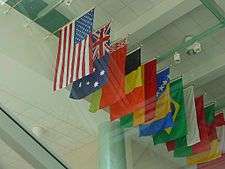
According to the tenth edition of American Universities and Colleges, published in 1968 by the American Council on Education, the University of North Alabama, then known as Florence State College, had only three international students enrolled during the 1966-67 academic year — two undergraduate students and one graduate student, all from the Middle East. However, during the Robert Potts administration, UNA undertook a concerted effort to diversify its student body by recruiting individuals from throughout the world. By 2004, international enrollment had grown to nearly 300 students representing 35 countries.[20]

Today, UNA has the third highest international student enrollment of any institution in its category according to U.S. News and World Report's America's Best Colleges. Roughly 10 percent of the UNA student body is international.[35] The Global Friendship Organization has become one of the largest and most influential student organizations on campus. A major focus of the GFO is organizing campus and community activities to integrate international students more closely with other UNA students and also with the surrounding Shoals community.[36]
Charmy Gupta, an MBA student from Gujarat, India, was selected as the 2007 Homecoming Queen.[37]
Media
- The Diorama, UNA's student-run yearbook, has won numerous awards competing at the national level with other yearbooks.[38]
- The Flor-Ala, named after Florence, Alabama, has functioned as the school newspaper since 1931. Published in 29 issues each year, the paper is run by UNA students who serve in all facets of news gathering, writing and production. The Flor-Ala is a member of the Associated Collegiate Press.
- Lights & Shadows, published once a year, is the university's award-winning literary and art magazine. Started as a publication of the Florence State Teachers College English Club in 1956, the magazine has earned numerous awards, including first place in the Southern Literary Association's annual competition.[39]
- "UNA Magazine", UNA’s alumni magazine published bi-annually.[40]
Athletics
UNA operates a successful collegiate athletic program in NCAA Division II's Gulf South Conference. The North Alabama Lions football, men's basketball, women's volleyball, and softball teams have each won national championships.
UNA operates 14 collegiate athletic programs in NCAA Division II’s Gulf South Conference (GSC). The lions have collected more than 40 conference championships, dozens of No. 1 national rankings and seven national titles![41]
Greek life
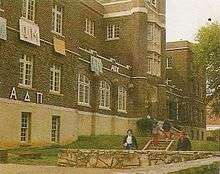
UNA's Greek system is approaching its 40th anniversary. The university's embryonic Greek community initially was housed in O'Neal Hall, which was demolished in the 1980s to clear space for the construction of the Guillot University Center.
Fraternities
Robert Guillot, president from 1972 to 1989, accurately could be described as the father of UNA Greek life. He chose seven national fraternities to colonize UNA, stipulating that all chapter colonies had to be granted charters by November 1, 1974. Failure meant dissolution and replacement by new groups, which, in turn, could petition the same or other selected national fraternities for affiliation.
The threat apparently worked. Chartered fraternity chapters - Alpha Tau Omega, Delta Chi, Kappa Sigma, Phi Gamma Delta, Pi Kappa Alpha, Lambda Chi Alpha (closed 1981) and Sigma Chi - began acquiring off-campus lodges that over time were upgraded to or replaced by fraternity houses. Kappa Sigma's Lambda-Omicron chapter was the first chapter to acquire an off-campus lodge, the site of the present-day Off-Campus Bookstore.[42]
Kappa Sigma's Lambda-Omicron chapter was the first fraternity to construct a house on UNA's fraternity row, which opened on April 4, 1984.[43]
Sigma Chi's Eta Rho Chapter at the University of North Alabama served as the international fraternities' first official colony. Eta Rho is the Alpha colony of Sigma Chi
Sororities
A similar strategy was followed with sorority recruitment. As with the fraternities, invitations were extended to national sororities with the strongest alumni presence in the Florence area and, consequently, with the best prospects for success - Alpha Delta Pi, Alpha Gamma Delta, Alpha Omicron Pi (no longer on campus), Phi Mu, and Zeta Tau Alpha.
Young women interested in joining the emerging Greek system were encouraged to sign up for recruitment and subsequently were divided into several groups to visit rooms on campus assigned to sorority recruiters. In the interest of fairness, only four alumnae could be present in each of these rooms while recruiting occurred.[44]
Alpha Delta Chi Christian Sisterhood at UNA was founded in 2006. The group functions as a student organization outside the Greek system.
Greek system today
President Guillot's decision to organize a UNA Greek system was greeted with strong opposition by some segments of the administration. Previous attempts to establish a Greek community had been resisted for years.[44]
Nevertheless, almost two generations after its founding, UNA Greek life is alive and well, even though fraternities and sororities combined represent slightly less than 10 percent of the undergraduate student population. Despite these comparatively small numbers, Greeks historically have exerted a major influence on virtually every facet of student life at UNA.[45]
Inter-Fraternity Council
Alpha Tau Omega, Founded January, 1974
Delta Chi, Founded September, 2006
Kappa Sigma, Founded May 4, 1974
Phi Gamma Delta, Founded March 23, 1974
Pi Kappa Alpha, Founded March 3, 1974
Sigma Alpha Epsilon, Founded February 24, 1989
Sigma Chi, Founded April 20, 1974
National Panhellenic Council
Alpha Delta Pi, Founded February 17, 1973
Alpha Gamma Delta, Founded 1975
Phi Mu, Founded March 2, 1973
Zeta Tau Alpha, Founded March 3, 1973
National Pan-Hellenic Council
Alpha Phi Alpha, local chapter founded January 17, 1975
Kappa Alpha Psi, local chapter founded October 10, 1976
Phi Beta Sigma, local chapter founded December 4, 2010 (initially colonized December 2, 1998)
Alpha Kappa Alpha, local chapter founded December 7, 1980
Delta Sigma Theta, local chapter founded April 12, 1980
Zeta Phi Beta,[46] local chapter founded November 22, 2003
Traditions
| UNA Fight Song | ||
| Go, Fight for U-N-A | ||
| We are behind you all the way | ||
| Go Fight! Win Ole U-N-A | ||
| The Purple and Gold is here to stay | ||
| We'll roar on to victory | ||
| We'll send that team back on their way | ||
| Go! Fight! U-N-A | ||
| We are behind you all the way | ||
| (Cheer) | ||
| Go! Fight! U-N-A | ||
| Go! Fight! U-N-A | ||
| Go! Fight! U-N-A | ||
Go-Fight-Lions!
|
School colors
Purple and gold are the school colors of the University of North Alabama. While they are a ubiquitous sight on campus and especially at UNA athletic events, no one has ever ascertained who or what inspired their adoption. Little in the school archives accounts for the origin of these colors, according to Cecil Nabors, a UNA archivist and associate professor. All that is certain is that the 1912 yearbook, published the same year as inauguration of the football team, was named the "Purple and Gold."[47]
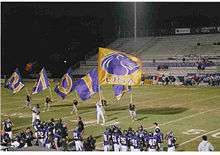
UNA Fight Song
The "UNA Fight Song" is the fight song of the University of North Alabama, and is played by the Pride of Dixie Marching Band. The song is based on one of three songs called "Three School Songs," which was published in the 1960s. The lyrics were chosen by band members in the late 1970s.[48]
"Lion Pride" and "Pride Rock"
"Lion Pride" is a term frequently used by members of the UNA community to describe the intense level of commitment to school traditions and activities reflected among students, alumni and friends of the university.[49]
Perhaps nowhere is this level of commitment more strongly expressed than in the university's Pride Rock tradition, which began in 1994. Pride Rock is a 60-pound, engraved granite stone bearing the actual paw print of Leo II, UNA's second live lion mascot. Placed just behind the north end zone of all UNA home games, Pride Rock is touched by players as they file past on their way to the field. Pride Rock serves not only as a motivational tool for the players but also as a tangible expression of the deep well of pride, community and tradition associated with the University of North Alabama and particularly with its athletic program.[50]
UNA's mascot
Leos I and II
On July 22, 1974, former UNA president Dr. Robert M. Guillot brought a 35-pound lion cub to the campus and Leo spent the next 14 years "roaring" the school to victory. The original Leo died on Jan. 20, 1988, and a great outpouring of support from the Shoals community resulted in Leo II being brought to UNA in July 1988. Leo II lived in the compound that once housed the original Leo and grew to a weight of more than 600 pounds at eleven years of age. In 1997, Leo II was selected as the nation's "Second Best Mascot" by Sports Illustrated. He died in February, 2000.[51]
Leo III and Una
UNA once again boasts the only live Lion mascots in the country living on campus. Leo III and Una, born on November 18, 2002, now reside on the campus in the 12,764-square-foot (1,186 m2) George H. Carroll Lion Habitat. UNA's other mascots, students who don lion costumes (one male one female) to cheer the Lions and entertain the crowd, also represents the school at athletic games and other university functions. Tryouts are held each year and the identity of the students are kept secret for as long as possible.[51]
Miss UNA Scholarship Pageant
The Miss UNA Scholarship Pageant is an official preliminary for the Miss Alabama/Miss America Pageant. The Miss UNA Scholarship pageant has been a UNA tradition for over 31 years. The pageant provides an opportunity for the university's young women to compete in the following categories for scholarship money and prizes. In 2007 over $12,000 in scholarships and prizes was awarded to the contestants. Each young woman is encouraged and mentored to develop skills that will enrich her personal and professional life beyond her university experience. Miss University of North Alabama spends her year in service to the university and Shoals Area community. She promotes the platform of her choice, makes official appearances as a university representative, and represents the university at the Miss Alabama Scholarship Pageant.
Spirit Hill Tailgating and Lion Walk
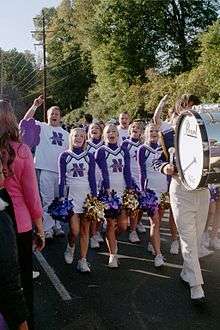
Within the past few years, pregame tailgating at Spirit Hill, an area adjoining Braly Municipal Stadium, has developed into a major UNA tradition, thanks largely to the efforts of former Athletic Director Joel Erdmann. Erdmann enlisted the UNA Greek community, general student organizations and alumni to expand this tradition, which had been lacking.
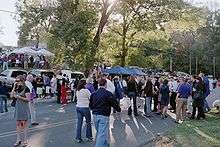
Along with former head UNA football Coach Mark Hudspeth, Erdmann also was instrumental in developing the highly popular Lion Walk, a pregame parade down Royal Avenue (next to Spirit Hill) that includes Lion athletes, cheerleaders and the Pride of Dixie Marching Band. The parade is held before every UNA home game.[52]
UNA's "Pride of Dixie" Marching Band
The Pride of Dixie Marching Band was founded in 1949. The Marching Band has represented the university at many different events since, including a performance for President Jimmy Carter during his historic 1980 visit to neighboring Tuscumbia.
The band also appeared in the award-winning movie, Blue Sky, starring Jessica Lange, Tommy Lee Jones and Powers Boothe. The Marching Band also has recorded a CD with famed musician and producer Jimmy Johnson.
With more than 210 members, the group is the largest organization on campus and serves as a major contributor to school spirit, especially at athletic events. The UNA Marching Band performs at all home football games, local parades and travels the state performing in exhibition at high school competitions. They are known for precision marching and drill design, while entertaining with strongly played jazz standards.[53]
Step Sing
In the spring, Step Sing is a well-attended event in Norton Auditorium sponsored by the University Program Council featuring take-offs of musical comedy production numbers by campus organizations. Money raised from ticket sales supports the local United Way.[54]
UNA gallery

Keller Hall 
Walkway, facing toward Guillot Center 
Keller Hall 
Walkway, facing toward Wesleyan Hall 
18th-century Japanese Lantern 
Powers Hall 
Amphitheater and ROTC Memorial
UNA in nonfiction
Baker roots
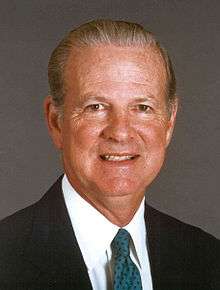
Former U.S. Secretary of State James Baker, III, stumbled upon a major family discovery sparked by a visit to Florence, where he delivered the 2002 annual commencement address at the University of North Alabama - a discovery he discusses in his autobiography "Work Hard, Study...and Stay out of Politics." The former secretary's ancestors resided in antebellum Florence before settling in Texas.[55]
Bare-knuckle debate
In the mid-1960s, the University of North Alabama, then known as Florence State College, was the site of a bare-knuckle debate between then-Governor George C. Wallace and Senator Ed Horton, a North Alabama state legislator and a vocal opponent of the governor's attempt to amend the Alabama Constitution so that he could run for an unprecedented second term. The debate is outlined in Dan T. Carter's book "The Politics of Rage: George Wallace, the Origins of the New Conservatism, and the Transformation of American Politics."[56]
UNA people
Alumni and other former students of the University of North Alabama include business leaders; a number of governors, congressmen and other government and military leaders; professional athletes; artists and entertainers.
References
- ↑ https://www.una.edu/graphic-standards/docs/StyleGuide_rev11.3SM.pdf
- 1 2 "Description of the University: History and Location," University of North Alabama Catalog, 2006-2007
- 1 2 3 4 5 6 Jarnigan, Bill. "Facts and Figures about UNA," Office of University Relations, University of North Alabama
- ↑ Palmer, Michael E. (April 25, 2009) "LaGrange College is Alabama's birthplace of higher education" Tuscaloosa News
- ↑ Eubanks, Michelle "UNA gets top tier ranking in colleges report"
- 1 2 3 4 5 6 7 8 9 Smith, William E., "Leo's Tale: University of North Alabama Trivia, Florence, AL, Shoals Heritage Publishers, 2000.
- 1 2 3 4 5 "The University of North Alabama Staff Handbook," University of North Alabama
- ↑ Howard, Pat "Civil Rights Pioneer Says Struggle Continues" Florala (University of North Alabama), November 17, 2005
- ↑ "Appointment of Wendell Wilkie Gunn as a Special Assistant to the President" Ronald Reagan Presidential Archives, National Archives and Records Administration, April 19, 1982
- ↑ "UNA President-Elect Dr. William Cale Visits Campus Again," Office of University Relations, University of North Alabama, November 19, 2004
- ↑ http://www.scnow.com/news/local/article_57f77686-7960-5841-b048-45b4f1e67c02.html
- ↑ Seminary O'Neal History District, Florence, Historical Marker, Florence Historic Board, Florence, Alabama.
- 1 2 3 4 5 6 7 8 9 "UNA Public and Tourist Attractions". University of North Alabama. Archived from the original on 2007-06-16.
- 1 2 "Harrisons Present Plaza and Fountain to UNA," Office of University Relations, University of North Alabama
- ↑ Rachal, Bryan. "UNA's Science and Technology Building is Everything and More". UNA.edu. University of North Alabama. Retrieved 25 November 2016.
- ↑ Pace, Terry. "UNA's New Commons Building Provides Academic Services, Retail Outlets, Gathering Place for Students and Shoals Community". UNA.edu. University of North Alabama. Retrieved 25 November 2016.
- ↑ Rachal, Bryan. "University of North Alabama Breaks Ground On New Residence Halls". UNA.edu. University of North Alabama. Retrieved 25 November 2016.
- 1 2 3 4 "University of North Alabama Virtual Tour," University of North Alabama
- ↑ Howard, G. Daniel, "Restoration of Coby Hall, UNA Magazine, Summer, 2005
- 1 2 Steen, Robert S., "The 175-Year March from the 19th into the 21st," UNA Magazine, Summer, 2005
- ↑ "University of North Alabama Virtual Tour of Campus," University of North Alabama
- ↑ Eubanks, Michelle Rupe. "Growing Fast" The Times Daily, April 15, 2007
- ↑ Kitts, Ken. "Academic Departments and Programs: Majors & Minors". UNA.edu. UNA. Retrieved 25 November 2016.
- ↑ "Why Choose UNA?" Roarlions.com, Official Site of University of North Alabama Athletics
- ↑ "University of North Alabama Graduate Majors" UNA International Student Services
- ↑ "MA Graduate Program in History," Department of History and Political Science, University of North Alabama
- ↑ Melvin, Elizabeth, "Master Degrees are History," Flor-Ala, August 23, 2007.
- ↑ Melvin, Elizabeth, "New Major Cooking at UNA," Flor-Ala, August 24, 2007.
- ↑ "University of North Alabama Balancing Education and Research Opportunities," Mens Football, NCAAsports.com
- ↑ http://www.una.edu/honors
- 1 2 3 "Accreditation," University of North Alabama
- ↑ Kitts, Ken. "University of North Alabama Accreditation". UNA.edu. UNA. Retrieved 25 November 2016.
- ↑ Kitts, Ken. "University of North Alabama Accreditation". UNA.edu. UNA. Retrieved 25 November 2016.
- ↑ Eubanks, Michelle Rupe "UNA remains unranked among top universities," The Times Daily, May 22, 2007
- ↑ "Top 100 campuses with most International Students: Universities–Master's (South)," America's Best Colleges, U.S. News and World Report
- ↑ "International Student Services, University of North Alabama
- ↑ "Alexander, Gupta named Homecoming King, Queen," Office of University Relations, University of North Alabama
- ↑ "Diorama Wins National Awards," Office of University Relations, University of North Alabama, Nov. 8, 2001.
- ↑ "Lights and Shadows," University of North Alabama
- ↑ Lyles, Carol. "UNA Alumni Magazines". UNA.edu. UNA. Retrieved 25 November 2016.
- ↑ "Championships/Post-Season," RoarLions.com, Official Site of University of North Alabama Athletics
- ↑ "Chapter History," Eta Rho Chapter, Sigma Chi"
- ↑ "Capital Campaign," Lambda-Omicron Alumni Association Chapter, Kappa Sigma
- 1 2 "The State of ZTA, Zeta Tau Alpha Fred, April, 2004
- ↑ "University of North Alabama, Extracurriculars," U.S. News and World Report: America‘s Best Colleges and Universities, 2007
- ↑ "North Alabama Greeks," University of North Alabama
- ↑ "Riley, Show School Spirit," Tuscaloosa News, Aug. 31, 2007.
- ↑ http://www.timesdaily.com/article/20080913/ARTICLES/809130333/0/MISC
- ↑ "Life at UNA: Traditions," University of North Alabama
- ↑ "Pride Rock," RoarLions.com, Official Site of University of North Alabama Athletics
- 1 2 "Live Mascot Tradition Continues," RoarLions.com, Official Site of University of North Alabama Athletics
- ↑ "S.E. Louisiana's gains are UNA's heart-felt losses," The Decatur Daily, July 17, 2007.
- ↑ "The University of North Alabama Band:The Pride of Dixie," University of North Alabama
- ↑ "Life at UNA: Step Sing," University of North Alabama
- ↑ Baker, James. "Work Hard, Study, and Stay Out of Politics, 2006, Amazon.com
- ↑ Carter, Dan T.,"The Politics of Rage: George Wallace, the Origins of the New Conservatism, and the Transformation of American Politics, 2000, Amazon.com
External links
| Wikimedia Commons has media related to University of North Alabama. |